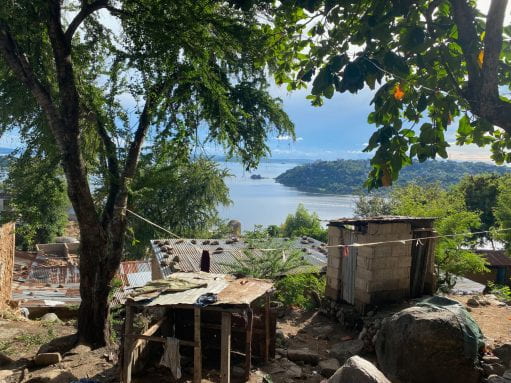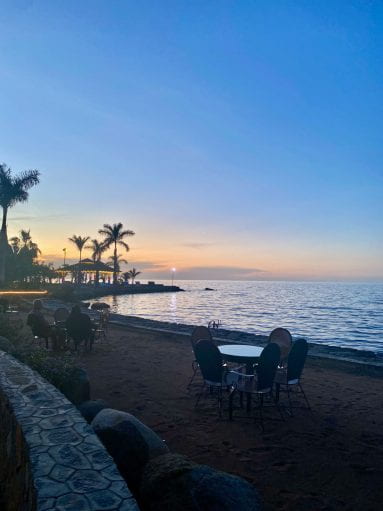We know your problem, and we’re going to fix it
By Dana Sousa-Limbu, on 20 September 2023
A blog written by Tywen Thomas, 2022-23 student of the Environment and Sustainable Development MSc

Settlements underneath trees with a view of Lake Victoria in Tanzania
Invisible Domination
Until recently, I had been happy to engage with decolonisation at a discursive or theoretical level, using it as a guideline for political thought and action. My personal politics, leaning on a historical materialist understanding of the injustices of capitalism, often align with strands of decolonial thought. I have sympathised with and supported decolonial initiatives that some would term radical, such as the return of land and its socio-economic power to its rightful indigenous stewards. In hindsight, I leaned on these moments of alignment to justify a lack of further work and self-reflection. Confident in a surface-level application of what decolonisation could be, I had not worked to come to my own nuanced understanding of what it meant for me and how my decisions, and very existence, fit within it.
Decolonisation has been woven throughout the Environment and Sustainable Development programme. I digested assigned readings on topics such as decolonising academia in South Africa. As a white Canadian studying in the seat of empire, I was aware of the inherent conflicts and potential hypocrisy.
Reckoning with your relationship to decolonisation is not a simple process. The majority of people in my privileged position have not done the work. This fact indicates the entrenched coloniality of Western society. Maistry (2019) explains the difference between colonialism and coloniality:
“The former refers to the institutional or legislative governing power of the coloniser over the colony as a result of military conquest. Its counterpoint is decolonisation, the ‘return’ of the colonised territory to its original inhabitants. Coloniality, on the other hand, is a systematic, enduring process of displacement of indigenous ontologies and epistemologies within that of the colonisers… it permeates all aspects of our contemporary existence, our dress, consumption patterns, values, aspirations and our worldviews. It holds an ideological hegemony over the social, economic and political” (page 186).
Using this interpretation, I have long aligned ideologically with decolonisation – the return of indigenous lands – for various reasons, from justice to climate practicality. However, problematically from the perspective of continuing to frame decolonisation as a vague concept to ideologically align with, this understanding of decoloniality asks much more of the individual.
A difficult realisation comes with acknowledging the degree of my entanglement in the ontological supremacy of Western worldviews. Despite ongoing efforts to decolonise the curriculum I have been studying, the media I engage with, and the institutions I am a part of, it will take a concerted effort on my part to mitigate my complicity in perpetuating coloniality. How does one decolonise their thought patterns, ways of knowing, and attitudes towards the world?
These complex thoughts swirled as my colleagues and I deliberated on how to best approach each coming day of our fieldwork in Tanzania. While it is no longer a German or British colony, contemporary Tanzania exists in a reality inseparable from coloniality. Not only were our ideas, proposed solutions and approach as researchers sitting in this shadow, but so were many of the existing Tanzanian ideas, ongoing attempts at solutions, and the hierarchical structure of stakeholders. Again from Maistry (2019):
“coloniality then is the ever-pervasive ‘invisible’ structure of management and domination in contemporary society. Its counterpoint, decoloniality might refer to the project of disrupting coloniality’s cycle of reification” (page 187).
Speaking with people experiencing simultaneous realities so different to mine brought into sharp focus that my capacity to envision a solution free from the coloniality that supports these realities is limited by my ability to escape my own coloniality. I might be able to empathise with those suffering in large part due to the extant coloniality of their society. Still, I will never be able to experience their reality (Maistry 2019 from Burrell and Flood 2019).

Dining tables on the waterfront in Tanzania during sunset
Constructing Imaginaries
One of the identifiable manifestations of coloniality in the context of our work in Mwanza was in the discourse around infrastructure. The discussion was frequently binary, have or have not, the unimproved or the upgraded, connected or unconnected. It did not take a sophisticated analysis to determine who or what was likely to fit into which category or to hypothesise why that might be the case. As Fanon wrote in his famous and sadly still pertinent work The Wretched of the Earth:
“The colonial world is a compartmentalised world…The colonised world is a world divided in two.” (Fanon 2004, page 3).
This compartmentalised, divided world was evident in Tanzania. We stayed in a gated hotel set in stark relief to the surrounding unplanned settlement. Our buses lurched down unpaved roads over channels carved by previous rains before popping out onto a smooth arterial highway. The tall buildings in the bustling centre of Mwanza illuminate the night sky while providing a view of squat tin-roofed communities perched on surrounding hillsides conspicuous in their relative darkness. These contrasting inequalities of capitalist imperialism are softened in the centres of colonial power where I come from, with much of the unsightly struggle and exploitation exported to the so-called developing world to sustain the reification of coloniality.
Infrastructure plays a complicated role in this dichotomy. It is a tool to create and sustain this disparity while also representing a potential path across the chasm. In development discourse, infrastructure can lift a household, a community, or a city across the divide. However, infrastructure as a construct is characterised by a duality: it can support motion and mobility but also restrict and limit.
“every day by neglect or design infrastructure fails to meet basic needs. But this conception of infrastructure, perhaps an engineer’s definition, is only one of its forms” (Cowen in Pasternak et al. 2023, page 2).
One of the biggest takeaways from our group’s work was recognising the utility of a broader people-centred conception of infrastructure, where people are more than the implementor, the beneficiary, or the victim. People themselves can form infrastructures. This people-centred view of infrastructure frees it from being limited to moving things or people, allowing it to play a role in creating emotion and, importantly, constructing realities (Cowen in Pasternak et al. 2023).
The most rewarding aspect of our project was working with community members to co-produce a sustainable ecological sanitation solution for their community. Participants grasped not only our theoretical framework of multi-scalar loops but applied a combination of theory and knowledge of sanitation technologies to imagine an alternate reality beyond the connected/unconnected binary.
Overwhelmingly, community members sought decentralised and community-driven solutions. The attraction is not hard to understand. Aside from a lack of trust in authorities, these solutions’ flexibility, adaptability, and potential empowerment works toward decoloniality by pushing against the hierarchical binaries of post-colonial realities.
Infrastructure provides opportunities to think about design, ownership, financing, process, labour, and each aspect’s political economies and ecologies (Cowen in Pasternak et al., 2023). These questions create space for community co-design, co-ownership, co-financing, etc., all of which serve as windows for decoloniality. However, we can go further.
There is yet more potential in moving conceptually beyond infrastructure as either human-made physical constructs or human-centred systems. Borrowing indigenous ways of knowing historically cast aside by coloniality, nature should be considered infrastructure.
“If we think of a river as infrastructure, then it’s not something that is built and then walked away from, nor something that just exists in space as material” (Spice in Pasternak et al. 2023, page 3).
The example of a river is particularly relevant to our work in Tanzania which exists in the context of efforts to improve water quality in the Lake Victoria watershed. If the watershed is seen as infrastructure alongside many that comprise a sanitation system, binary solutions give way to a broader understanding of potential avenues of improvement. This conceptual opening moves beyond the colonial dichotomy of have and have-not and leaves behind the constructed humanity-nature duality. This allows coloniality to be tackled not by opening a discursive window but by knocking down walls to identify processes and solutions that target root causes. As an indirect goal, supporting decoloniality aligns with many explicit intentions of social justice, aid, and research programmes. It also intentionally enables them to be lifted out of their colonial box, increasing the likelihood of real change being made along the way.
Citations
Fanon, F., Bhabha, H. K., & Sartre, J.-P. (2004). The wretched of the earth: Frantz Fanon. (R. Philcox, Trans.) (1st ed.). Grove Press.
Maistry, S. M. (2019). The Higher Education Decolonisation Project: Negotiating Cognitive Dissonance. Transformation: Critical Perspectives on Southern Africa, 100(1), 179–189. https://doi.org/10.1353/trn.2019.0027
Pasternak, S., Cowen, D., Clifford, R., Joseph, T., Scott, D. N., Spice, A., & Stark, H. K. (2023). Infrastructure, Jurisdiction, extractivism: Keywords for decolonising geographies. Political Geography, 101, 102763. https://doi.org/10.1016/j.polgeo.2022.102763
 Close
Close


